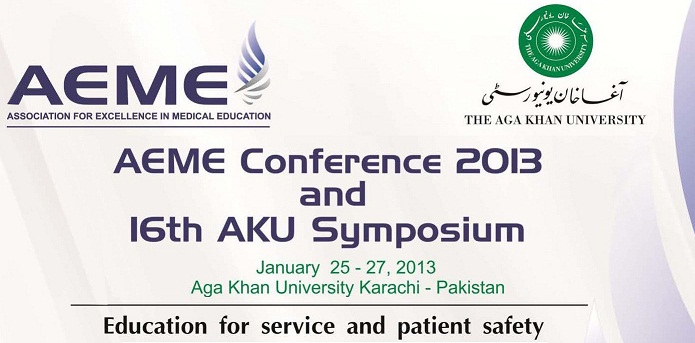Day 1 : Poster Presentations (Theme: Curricular Innovations)
A comprehensive plan to implement evidence based medicine curriculum in undergraduate program
Location
Auditorium Pond Side
Start Date
26-1-2013 10:30 AM
Abstract
Ziauddin Medical College was among the first medical colleges in Pakistan which has introduced integrated curriculum for M.B.B.S Program with concentration on teaching organ systems in preclinical years. There is considerable integration within the disciplines of Basic Health Sciences and Community Health Sciences, and limited integration of Clinical Sciences. Curriculum also have well structured Clinical clerkship program which provides students with good clinical exposure for Patient management. In year 2010, one additional “Clinical Skills Rotation” was added in clinical clerkship programme to provide additional procedural, communication and Evidence based medicine skills to students in their early clinical exposure. After successful implementation of EBM in 3rd year clerkship program me we are proposing a comprehensive plan of evidence based medicine curriculum in all 5 years of MBBS. EBM curriculum is presented here as a model and how it can be integrated into a medical curriculum.
Salient features of comprehensive plan
Role and Problem identification of EBM in medical curriculum,
Needs assessment
Goals and Objectives of EBM
Educational strategies
Resources and personals requirement
Faculty resistance.
Ethical issues
Users of curriculum.
Evaluation and feedback.
Assessment plan
Dissemination.
Curriculum maintenance and enhancement of EBM curriculum.
Results: of the pilot project of 2 weeks 3rdyear M.B.B.S EBM program and details of the whole model of EBM Curriculum will be presented in the conference.
1. Sackett DL, Rosenberg WMC, Gray JAM, Haynes RB, Richardson WS. 1996. Evidence based medicine: what it is and what it isn't. BMJ 312: 71–2 [3].
2. Kligler B, Maizes V, Schachter S, Park CM, Gaudet T, Benn R, et al. Core competencies in integrative medicine for medical school curricula: a proposal. Acad Med. 2004 Jun;79(6):521-31.
3. Med Educ Online. 2009 Sep 20;14:15.
4. Tamim HM, Ferwana M, Al Banyan E, Al Alwan I, Hajeer AH. Integration of evidence based medicine into a medical curriculum:Med Educ Online. 2009; 14: 15.
5. Nicholson LJ, Warde CM, Boker JR. Faculty training in evidence-based medicine: improving evidence acquisition and critical appraisal. J Contin Educ Health Prof. 2007 Winter;27(1):28-33.
6. BMC Med Educ. 2010 Aug 19;10:58.
7. Ilic D, Forbes K.Undergraduate medical student perceptions and use of Evidence Based Medicine: a qualitative study.BMC Med Educ. 2010; 10: 58
8. Harden, RM, Susette Sowden, and WR Dunn. "Educational strategies in curriculum development: the SPICES model." Medical Education 18.4 (1984): 284-297. 9. Turner, Jim L, and Robert Boice. "Coping with resistance to faculty
A comprehensive plan to implement evidence based medicine curriculum in undergraduate program
Auditorium Pond Side
Ziauddin Medical College was among the first medical colleges in Pakistan which has introduced integrated curriculum for M.B.B.S Program with concentration on teaching organ systems in preclinical years. There is considerable integration within the disciplines of Basic Health Sciences and Community Health Sciences, and limited integration of Clinical Sciences. Curriculum also have well structured Clinical clerkship program which provides students with good clinical exposure for Patient management. In year 2010, one additional “Clinical Skills Rotation” was added in clinical clerkship programme to provide additional procedural, communication and Evidence based medicine skills to students in their early clinical exposure. After successful implementation of EBM in 3rd year clerkship program me we are proposing a comprehensive plan of evidence based medicine curriculum in all 5 years of MBBS. EBM curriculum is presented here as a model and how it can be integrated into a medical curriculum.
Salient features of comprehensive plan
Role and Problem identification of EBM in medical curriculum,
Needs assessment
Goals and Objectives of EBM
Educational strategies
Resources and personals requirement
Faculty resistance.
Ethical issues
Users of curriculum.
Evaluation and feedback.
Assessment plan
Dissemination.
Curriculum maintenance and enhancement of EBM curriculum.
Results: of the pilot project of 2 weeks 3rdyear M.B.B.S EBM program and details of the whole model of EBM Curriculum will be presented in the conference.
1. Sackett DL, Rosenberg WMC, Gray JAM, Haynes RB, Richardson WS. 1996. Evidence based medicine: what it is and what it isn't. BMJ 312: 71–2 [3].
2. Kligler B, Maizes V, Schachter S, Park CM, Gaudet T, Benn R, et al. Core competencies in integrative medicine for medical school curricula: a proposal. Acad Med. 2004 Jun;79(6):521-31.
3. Med Educ Online. 2009 Sep 20;14:15.
4. Tamim HM, Ferwana M, Al Banyan E, Al Alwan I, Hajeer AH. Integration of evidence based medicine into a medical curriculum:Med Educ Online. 2009; 14: 15.
5. Nicholson LJ, Warde CM, Boker JR. Faculty training in evidence-based medicine: improving evidence acquisition and critical appraisal. J Contin Educ Health Prof. 2007 Winter;27(1):28-33.
6. BMC Med Educ. 2010 Aug 19;10:58.
7. Ilic D, Forbes K.Undergraduate medical student perceptions and use of Evidence Based Medicine: a qualitative study.BMC Med Educ. 2010; 10: 58
8. Harden, RM, Susette Sowden, and WR Dunn. "Educational strategies in curriculum development: the SPICES model." Medical Education 18.4 (1984): 284-297. 9. Turner, Jim L, and Robert Boice. "Coping with resistance to faculty

